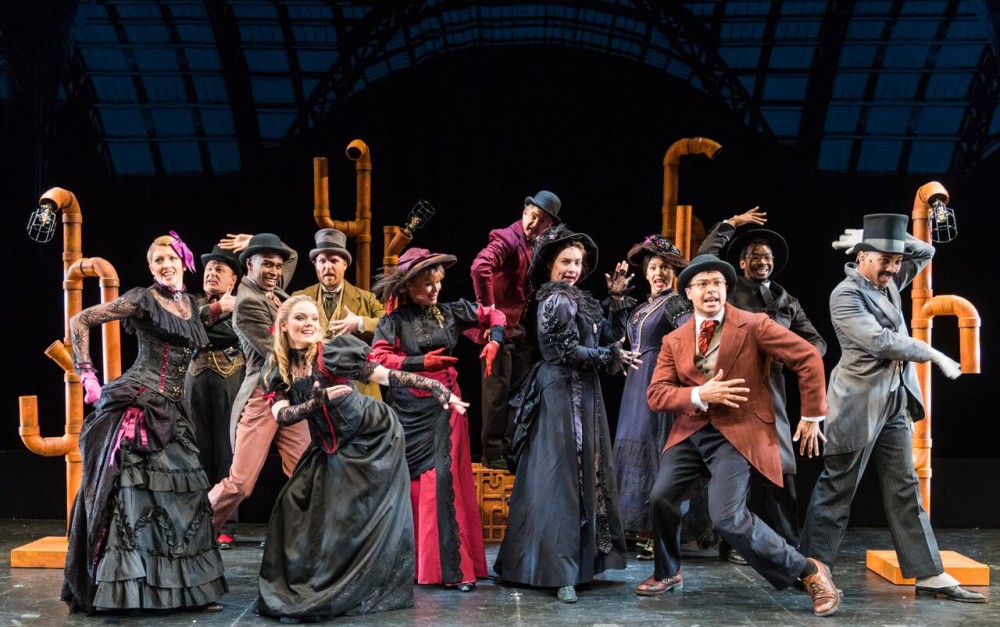
Matthew Beard, Lesley Manville, Jeremy Irons,
by JK Clarke
To bring a production of Long Day’s Journey Into Night to New York City only two years after the powerful, arresting and Tony award-winning Roundabout Theater Company Broadway revival starring Jessica Lange and Michael Shannon takes, in the politest terms, moxie. It would have to be headlined by stars of the highest caliber and with a flawlessness that rejects any need to make comparisons. So it’s a good thing that that’s exactly what the Bristol Old Vic production (visiting BAM’s Harvey Theatre through May 27), under the direction of Sir Richard Eyre and starring Jeremy Irons and Lesley Manville, has to offer.
Eugene O’Neill’s mostly autobiographical meditation on a dysfunctional and substance-addled New England family is unsettling (at the very least) when properly performed. Depressing and heart-rending also comes to mind. The story of the emotionally repressed Tyrone family in a seaside New England town, whose youngest of two children, Edmund (Matthew Beard), appears to be coming down with consumption (which was essentially code for tuberculosis at the time). The stress is leading his mother, Mary (the wonderful Lesley Manville, somewhat reminiscent here of fast-talking Katharine Hepburn in the 1962 film adaptation), recently released from a rehab clinic, to backslide into her morphine addiction. Her relapse is sending her husband, James (Jeremy Irons, proving he’s legendary for a reason), a washed up Broadway star and judgmental eldest son, James, Jr. (Rory Keenan) into paroxysms of worry and scorn, despite their own tendency to seek emotional refuge in a whiskey bottle.


Jeremy Irons, Matthew Beard
One of the fundamental differences between this production and the 2016 Roundabout production is the simmering emotional repression that seemed ready to burst forth at any moment, as particularly evinced by Michael Shannon, but also by Lange, and is easily read as the motivation behind the various brands of substance abuse. It’s the New England, Puritan (or WASP, if you will, despite the fact that the Tyrones, like O’Neill’s family, are Catholic) -flecked emotional stifling that appear to be somewhat lost on the UK-based cast in the Old Vic production. To be fair, it’s a tough concept to understand without having lived it. There’s something particularly American about that moral hypocrisy. It could explain why Beard’s Edmund is a so much more a sympathetic character, giving the play more a feeling of personal tragedy than pathological emotional terror.
An interesting component of this new production is the surreal tone created by Rob Howell’s dual-era set. Despite following O’Neill’s notes carefully, the interior, apart from what feels like an unusually high ceiling, is laid out according to instructions, feeling decidedly New England, with wicker love-seats, early century wood tables and floors, and a an elegant secretary/roll-top desk. But the walls, made of some synthetic material, glow oddly when back lit (lighting—Peter Mumford), at times transparent (allowing us to see characters standing outside or arriving at the front door; the walls at times feel as if they’re reflecting the nearby sea (you can almost see the reflection of surfside ebb and flow) and at others appearing as the somber wood slats in a study/library. It’s a mesmerizing effect, but also unsettling, for such a thing doesn’t fit in what is otherwise period perfect, as are Howell’s gorgeous Victorian costumes, right down to Mary’s stately Gibson Girl updo, which restrains the gorgeous long tresses she once treasured.


Lesley Manville
Long Day’s Journey Into Night is a must see when performed as magnificently as this. But in an ominous twist, almost in a rebuff of Death of a Salesman’s famous cri de coeur, the message here is that “Attention must not be paid.” Leave us alone, let us wallow in the substance that helps us escape from the misery we’ve stumbled upon or created for one another. It’s American misery at its finest.
Long Day’s Journey Into Night. Through May 27 at BAM’s Harvey Theatre (651 Fulton Street at Ashland Place; Fort Greene, Brooklyn). Three hours, 20 minutes with one intermission. www.bam.org
Photos: Richard Termine






















